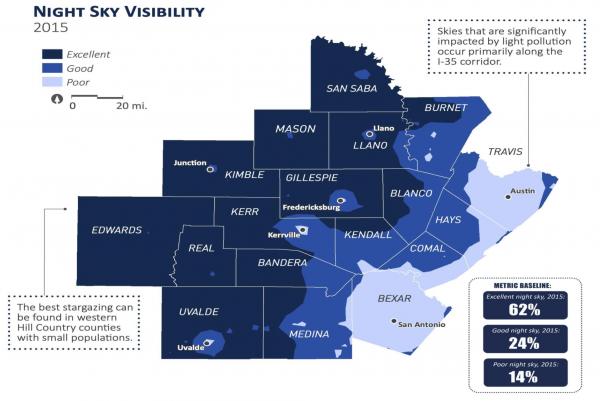Be a Friend to the Night Sky
Protecting the night sky is not just about the stars, as magnificent as they may be.
Hays County Friends of the Night Sky works to counteract the conventional view that more people and buildings automatically means more light pollution. HCFNS formed in 2018 to protect and restore local night skies, increase safety, reduce energy costs and waste and enhance the health of local people, plants and animals.
HCFNS is not alone in its mission. Dripping Springs became the first International Dark-Sky Community in Texas in 2014. Wimberley and Woodcreek gained the certification in 2018, and Buda is working toward it now. Throughout the Hill Country, more than two dozen municipalities have adopted outdoor lighting ordinances, and fellow Friends of the Night Sky organizations are active in at least seven other counties.
A major problem, however, is the absence of county authority or control in unincorporated areas of the county, where much of the sprawling residential, commercial and industrial development takes place. In some cases, but not nearly enough, developers agree to voluntarily adhere to dark sky guidelines.
Through education and outreach, HCFNS is trying to inform how light pollution affects everyone, and there are numerous ways to make a difference. The organization encourages people to install lighting only to the level of light needed to do the job, select warm-colored lights and use shielding and downward-facing lights. Energy saving controls on outdoor lights are also helpful, such as timers, dimmers and motion sensors.
The idea that bright lights are essential for safety is not always the case. Glaring spotlights, for example, may provide shadows as hiding places and actually obscure one’s view.
Similarly, many believe turning on a light and leaving it on all night comes at a relatively low cost. Not only is this practice of allnight lighting a significant drain on energy supplies, but there is also an impact on climate change and an increase to your monthly electric bill. Just leaving one 100-watt bulb on each night for a year is the energy equivalent of burning a half-ton of coal, according to the International Dark-Sky Association.
Many animals and plants are nocturnal, and the absence of true darkness can impact reproductive cycles and pollination. One of the most visible campaigns recently is the Lights Out Texas program to protect the billions of birds migrating through Texas each spring and fall. HCFNS joined with government, businesses and community organizations in a “Lights Out, Hays County!” campaign to localize the statewide message.
Every incorporated city in Hays County — as well as the county government itself — signed on to the campaign, asking everyone to turn off non-essential lights from 11 p.m. to 6 a.m. during the spring migration period through June 15.
“Using light responsibly matters every night for many reasons, but it is especially important during spring and fall bird migrations,” said Larry Calvert, Hays County Master Naturalist board member. The majority of migrating birds travel at night and, as a result, light pollution is one of the biggest threats they face. Artificial light at night can cause migrating birds to become disoriented, which can then lead to building collisions or interactions with other threats like outdoor cats. Millions of birds die each year as a result.
Other species, from bees to bobcats, are also impacted by light pollution. Even human health can be disrupted by light pollution, which suppresses natural melatonin levels and affects circadian rhythms.
While 62% of the Hill Country has “excellent” night sky visibility — according to the recent State of the Hill Country Report — even short-time residents of Hays County may notice that the clarity of the night sky has diminished in only a few years. Astronomy buffs often need to take their telescopes farther into the countryside as skyglow from light pollution advances.
The answer doesn’t have to be turning off all the lights if residents, businesses and industry learn how to use light responsibly. There are many good lighting recommendations at darksky.org, the website of the International Dark-Sky Association, and its Texas chapter, idatexas. org.
The economic impact from light pollution can be considerable. Astrotourism has become increasingly important in Dripping Springs and throughout the Hill Country. Some are already renaming the Great North American Solar Eclipse expected to happen in April 2024, as the Great Texas Hill Country Eclipse — since its best view path crosses much of the Hill Country.
It’s time to consider changing night lighting habits to celebrate all the wonder, beauty and health natural darkness provides.
Soll Sussman is a board member of Hays County Friends of the Night Sky and assistant regional manager for Central Texas for IDA Texas. Sussman also works as a consultant, developing cross-border ties and partnerships related to energy and the environment in the United States and Mexico.



